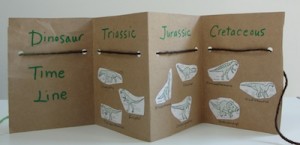Age 6-7yrs Ease *****
Many young learners find the concept of chronology a difficult concept to learn, especially in the context of longer periods of history. We adapted this idea from a similar project on dinosaurs created for older learners. Pupils will create a folding timeline book displaying modes of transport, or ‘Ways of travelling’ through history.
Description:
Allow learners to search the internet for pictures/photos of modes of transport. A good cross-section would be horse and cart, bicycle, car, bus, train, plane etc. Each child makes a folding book similar to the one featured on dinosaurs. Ask them to label 3 eras, we used “A very long time ago”, “Quite a long time ago” and “Today”. Some modes of transport will feature in two or more eras, but encourage learners to search for different styles of transport, for example 3 different styles of bicycles , one for each era.
Learners then print, cut out and glue their pictures in the correct sequence on their timeline.
What do I need?
- Internet access.
- Scissors
- Glue
- String
- Marker pens
Added value:
During the search process, learners must be discerning in the photos and pictures that they choose. It is also a platform for discussion and further research when they have to decide where, for example, a penny-farthing bicycle should be placed.
Hints and tips:
For less able learners, we provided them with a good selection of pictures and photos to get them started. They searched the internet in order to ‘fill gaps’ in their timeline. You could also ask them to order bicycles and trains only but have them search for all the required images – anything that cuts the task down into easier chunks.
Safety:
Online searches can produce images that you’d rather learners didn’t see so ensure you school has appropriate firewall protection.
Other opportunities to use the same software:
- effective Internet searching is harder for children to master than we often think and allowing them to search for specific and relevant thing on a regular basis is essential.
- Learning that there are types of searches (images, text, video) is important. As children get older, they can also deal with using different search engines e.g. www.wolframalpha.com See unit Savvy Searching for more details,
- Cut and paste images directly from the web to a PowerPoint presentation or a word document. If learners have good IT skills, they’ll be able to arrange and label the eras with limited assistance.





 English
English Nederlands
Nederlands Deutsch
Deutsch Italiano
Italiano Español
Español Português
Português Română
Română Cymraeg
Cymraeg
Create reusable versions by laminating the card. Learners then stick images on with tack and write on them in dry-wipe pens. I used mine several times a year over many years. They last at least 4 years if looked after!
Nice idea and I agree that looking for information on the internet is one of the core skills (young) learners should master.
I would be careful though with copying and pasting images directly from a website. Chances are that you’re copying more than you bargained for, which often makes documents very heavy.
Also have a look at a Timeline Tool like Dipity. This way you can create an online Timeline so you don’t have to laminate
Dipity is probably a bit much for learners this young, but I can imagine 10 to 12 year olds having fun with it. Unfortunately you’ll only get 3 timelines with your Free account, so that’s something to consider.
Thanks Jeroen! This is all great advice. Loving dipity! Here’s tutorial:
http://www.youtube.com/watch?v=8slBz1dtgXM
I would probably try this out with learners aged 9+, depending on their ability and IT competence. I understand that this will vary for others out there!
I don’t think the size of files matter too much as I don’t usually ask them to save them; just cut, paste and print the image. I always tell them not to save the file. I do, however, try and teach them to paste their images in the same document and print out when they have finished. This saves on paper because all their images have been resized and saved on one page, rather than having multiple printed
pages with one tiny picture in the corner of each!
Does anyone know of timeline software suitable for younger learners? I’d be more than happy to never laminate a timeline again!
Hi Nic
I will be on the lookout for timeline software for younger children.
In the mean time try out http://timerime.com. It has a few advantages when compared to dipity: you can embed audio and video, but you can also make as many timelines as you want with your free account. Each timeline is limited to a 100 items, but that still seems more than enough.
Thanks Jeroen! Timerime is great for very detailed and exact timelines; for example a timeline of Tudor kings and queens, because it requires exact day, month and year dates. When I tried creating a mock-up from the above activity, I hit some difficulties – trying to pin down the start and end date/time of the late triassic period (e.g. 1.30pm Tuesday March the 1st, 227 million years ago) is a bit awkward!
Has anyone found a way around this?
Otherwise it’s an excellent piece of software.